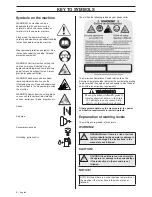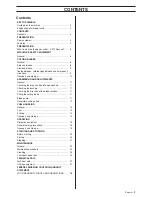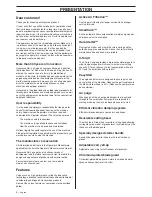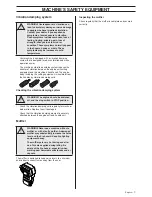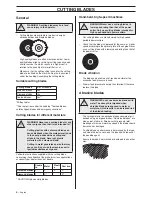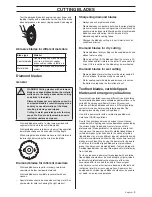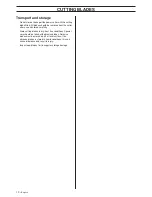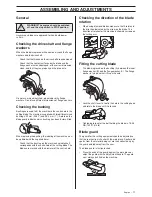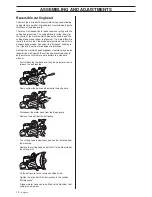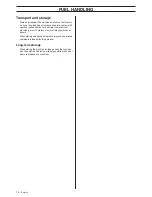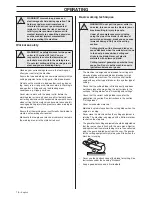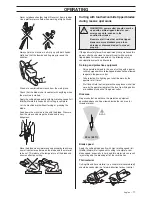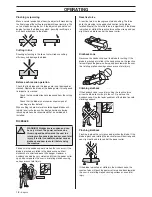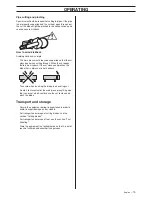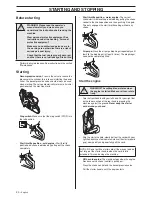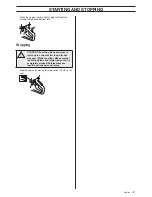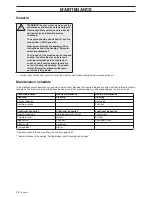
English
– 9
CUTTING BLADES
•
Test the abrasive blade by hanging it on your finger and
tapping it lightly with a screwdriver or the like. If the blade
does not produce a resonant, ringing sound it is damaged.
Abrasive blades for different materials
Diamond blades
General
•
Diamond blades consist of a steel core provided with
segments that contain industrial diamonds.
•
Diamond blades ensure lower costs per cutting operation,
fewer blade changes and a constant cutting depth.
•
When using diamond blades make sure that it rotates in
the direction indicated by the arrow on the blade.
Diamond blades for different materials
•
Diamond blades are ideal for masonry, reinforced
concrete and other composite materials.
•
Diamond blades are available in several hardness
classes.
•
Special blades should be used when cutting metal. Ask
your dealer for help in choosing the right product.
Sharpening diamond blades
•
Always use a sharp diamond blade.
•
Diamond blades can become dull when the wrong feeding
pressure is used or when cutting certain materials such as
heavily reinforced concrete. Working with a blunt diamond
blade causes overheating, which can result in the
diamond segments coming loose.
•
Sharpen the blade by cutting in a soft material such as
sandstone or brick.
Diamond blades for dry cutting
•
Diamond blades for dry cutting can be used both with and
without water cooling.
•
When dry cutting, lift the blade out from the cut every 30–
60 seconds and let it rotate in the air for 10 seconds to let
it cool. If this is not done, the blade may be overheated.
Diamond blades for wet cutting
•
Diamond blades for wet cutting must be water cooled. If
this is not done, the blade may be overheated.
•
Water cooling cools the blade and increases its service
life while also reducing the formation of dust.
Toothed blades, carbide tipped
blades and emergency situations
Government regulation requires a different type of guarding
for carbide tipped blades not available on power cutters – a so
called 360 degree guard. Power Cutters (this saw) use
Abrasive or Diamond blades and have a different guarding
system which does not provide protection against the
dangers presented by wood cutting blades.
Use of this power cutter with a carbide tipped blade is a
violation of OSHA regulations.
Due to the hazardous nature and exigent circumstances
involved with fire fighting and rescue operations conducted by
the various highly trained public safety forces, safety
professionals (fire departments), Husqvarna is aware that
they may use this power cutter with carbide tipped blades in
certain emergency situations due to the ability of carbide
tipped blades to cut many different types of obstructions and
materials in combination without having to take time to switch
blades or machines. When using this power cutter be aware
at all times that carbide tipped blades are more kickback
prone than abrasive or diamond blades if not used properly.
Carbide tipped blades can also throw pieces of material away
from the blade.
For these reasons, a power cutter equipped with a carbide
tipped blade should never be used except by highly trained
public safety professionals who are aware of the risks
associated with its use and then only in those exigent
circumstances when other tools are deemed inefficient and
ineffective to for fire or rescue operations. A power cutter
equipped with carbide tipped blade should never be used to
cut wood in non-rescue operations.
Blade type
Material
Concrete blade
Concrete, asphalt, stone masonry,
cast iron, aluminium, copper,
brass, cables, rubber, plastic, etc.
Metal blade
Steel, steel alloys and other hard
metals.
!
WARNING! Cutting plastics with a diamond
blade can cause kickback when the material
melts due to the heat produced when cutting
and sticks to the blade.
Diamond blades get very hot when used. An
overheated blade is a result of improper use,
and may cause deformation of the blade,
resulting in damage and injuries.
Cutting in metal generates sparks that may
cause fire. Do not use the machine near to
ignitable substances or gases.


